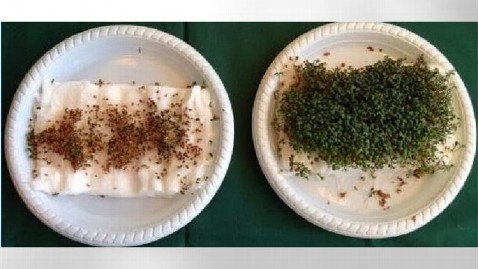
Can WiFi Signals Stunt Plant Growth?
May 24, 2013 http://abcnews.go.com/blogs/technology/2013/05/can-wifi-signals-stunt-plant-growth/
A Danish science experiment by a group of 9th-graders has gained worldwide interest and may have us rethinking the proliferation of wireless devices in our homes.
Five girls from Hjallerup Skole, a primary education school in Denmark, began the experiment after noticing that when they slept with their cellphones near their heads overnight, they had trouble focusing the next day, according to Danish News site DR.
The resources weren’t available to conduct an experiment around wireless signals affecting brain activity, so instead the girls decided to monitor the growth of plants near WiFi routers – and the results were a bit shocking.
Six trays containing the seeds of a garden cress herb were placed in a room without a WiFi router, and six trays were placed in a different room and next to two WiFi routers which, according to the girls’ calculations, emitted about the same type of radiation as an ordinary cellphone, reports DR.
During the 12 days of the experiment, the seeds in the six trays away from the WiFi routers grew normally, while the seeds next to the routers did not. In fact, the project photos show that many of the seeds placed near the routers turned brown and died.
“This has sparked quite a lively debate in Denmark regarding the potential adverse health-effects from mobile phones and WiFi-equipment,” Kim Horsevad, biology teacher at Hjallerup Skole told ABC News.
Horsevad said that some of the local debate over the experiment has been over whether the negative effects were due to the cress seeds drying from the heat emitted by the computer/WiFi routers used in the experiment. But she explained that the students kept the cress seeds in both groups sufficiently moist during the whole experiment, and the temperatures were controlled thermostatically.
A similar study was conducted about three years ago in the Netherlands when researchers noticed that some trees in urban areas were showing “bark lumps,” according to Popular Science. The experiment, conducted by Wageningen University, involved exposing 20 ash trees to various kinds of radiation for three months. The trees chosen to test tolerance to heavy WiFi signals began to show typical signs of radiation sickness, including a “lead-like shine” on their leaves.
As for the attention the girl’s science fair project is getting, Horsevad said neuroscience professor Olle Johanssen with the Karolinska Institute in Sweden has expressed great interest.
“[Johanssen] will probably be repeating the experiment in controlled, professional, scientific environments,” said Horsevad. “One would therefore generally be advised to await the results of his experiments before basing any important decisions on the outcome of the girls’ experiment.”
